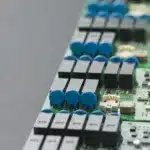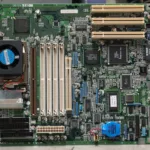Introduction
The power semiconductor industry is experiencing a significant transformation with the advent of Gallium Nitride (GaN) technology. GaN, a wide bandgap semiconductor material, is revolutionising power electronics by offering superior performance, efficiency, and power density compared to traditional silicon-based semiconductors. This article evaluates the key aspects of the GaN revolution, its advantages, versatile applications, and the future of power semiconductor technology.
Introduction to Gallium Nitride
Gallium Nitride is a binary III/V direct bandgap semiconductor material known for its wide bandgap, high electron mobility, and high-temperature tolerance in various high-frequency and high-power applications. Unlike silicon, GaN can operate at higher voltages and temperatures with exceptional electronic properties, making it more efficient and reliable for power semiconductor devices. The adoption of GaN technology has revolutionised various sectors, such as telecommunications, automotive, and aerospace, due to its potential in reducing energy consumption and improving system performance.
What are Power Semiconductors?
Power semiconductors refer to a key category of semiconductor devices specifically designed to handle high voltages and currents. These components are engineered to handle, control, and covert electrical energy efficiently in power electronics systems. Power semiconductors exhibit greater physical robustness and higher current capacity compared to general-purpose semiconductors. These electronic components come in various forms, including diodes, transistors, and thyristors, which are widely used in modern electronic systems for efficient and reliable management of electrical power.
How GaN is Transforming Power Semiconductor Technology? Advantages of GaN over Silicon
GaN is making significant inroads in the field of power semiconductor technology, notably transforming the efficiency and performance of power devices. The adoption of GaN over traditional silicon in various applications can be attributed to its superior material properties and performance metrics. Let’s explore how GaN is transforming the sector and its advantages over silicon:
Higher Efficiency
GaN devices exhibit lower conduction and switching losses compared to silicon devices. This leads to higher efficiency, especially in high-frequency applications. The reduced energy loss translates to less heat generation, which simplifies thermal management and improves the overall reliability of electronic systems.
Faster Switching Speeds
GaN transistors can switch at much higher frequencies than their silicon counterparts. This allows smaller and lighter components and higher power densities. The faster switching speeds also enable more precise control in applications such as motor drives and RF amplifiers.
Greater Power Density
The high breakdown voltage and excellent thermal conductivity of GaN allow higher power densities. This means that GaN devices can handle more power in a smaller footprint, making them ideal for compact and portable electronic devices.
Enhanced Thermal Performance
GaN’s high thermal conductivity helps dissipate heat more effectively, reducing the need for extensive cooling systems. This is particularly advantageous in high-power applications where heat management is critical.
Versatile Applications of GaN Technology
The GaN revolution is reshaping multiple industries by offering innovative solutions to long-standing challenges in power electronics. Some of the key application areas include:
- Consumer Electronics – GaN technology is making its way into consumer electronics, providing faster charging solutions for smartphones, laptops, and other portable devices. GaN chargers are more compact and efficient, offering a significant improvement over traditional silicon-based chargers.
- Power Supplies and Converters – GaN-based power transistors and diodes are being increasingly adopted in power supplies, DC-DC converters, and inverters for their ability to achieve higher power density, efficiency, and reliability. These devices enable the development of smaller, lighter, and more energy-efficient power conversion systems for consumer electronics, data centers, electric vehicles, and renewable energy systems.
- Electric Vehicles (EVs) – The automotive industry is adopting GaN technology to enhance EV performance. GaN-based power electronics are used in inverters, onboard chargers, and DC-DC converters in EVs, offering higher efficiency and longer driving ranges.
- Renewable Energy – In the renewable energy sector, GaN devices are used in solar inverters and wind turbines. Their high efficiency and reliability help maximise energy conversion, enable smarter grid management, and reduce the overall cost of renewable energy systems.
- RF and Microwave Applications – GaN’s high-frequency capabilities make it ideal for RF and microwave applications, including radar systems, satellite communications, and wireless infrastructure. GaN amplifiers offer higher power output and better linearity, enhancing the performance of these systems.
- Aerospace and Defense – GaN technology is also finding applications in aerospace and defense systems which is a big revolution, where high-performance power electronics are essential for mission-critical applications such as radar systems, electronic warfare, and satellite communication. GaN-based devices offer significant advantages in terms of power density, frequency operation, and ruggedness, making them ideal for harsh operating environments.
Challenges and Future Prospects of GaN Technology
While GaN technology offers numerous advantages, it also faces certain challenges. The cost of GaN devices is currently higher than silicon due to the complexity of the manufacturing process and the need for specialised substrates. However, as production scales up and technology matures, costs are expected to decrease.
The future of GaN technology looks promising, with ongoing research and development aimed at improving device performance and reducing costs. One promising area of research is the integration of GaN devices with advanced packaging and cooling technologies to enhance thermal management and reliability. Additionally, efforts are underway to develop GaN-on-Silicon (GaN-on-Si) technology to leverage existing silicon manufacturing infrastructure and reduce production costs.
Final Thoughts
The GaN revolution is transforming the power semiconductor industry by offering unprecedented efficiency, performance, and power density. Further technological advancements in GaN technology will undoubtedly shape the future of power electronics, enabling more efficient and compact solutions across a wide range of applications. In the future, GaN technology can be proved as a cornerstone of next-generation power electronics, powering the transition towards a more sustainable, electrified, and interconnected world.





















